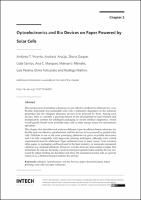Chapter 3 Optoelectronics and Bio Devices on Paper Powered by Solar Cells
| dc.contributor.author | Vicente, António T. | |
| dc.contributor.author | Araújo, Andreia | |
| dc.contributor.author | Gaspar, Diana | |
| dc.contributor.author | Santos, Lídia | |
| dc.contributor.author | Marques, Ana C. | |
| dc.contributor.author | Mendes, Manuel J. | |
| dc.contributor.author | Pereira, Luís | |
| dc.contributor.author | Fortunato, Elvira | |
| dc.contributor.author | Martins, Rodrigo | |
| dc.date.accessioned | 2018-07-20 23:55 | |
| dc.date.accessioned | 2019-10-04 14:44:28 | |
| dc.date.accessioned | 2020-04-01T12:34:18Z | |
| dc.date.available | 2020-04-01T12:34:18Z | |
| dc.date.issued | 2017 | |
| dc.identifier | 1000312 | |
| dc.identifier | OCN: 1076658820 | en_US |
| dc.identifier.uri | http://library.oapen.org/handle/20.500.12657/29623 | |
| dc.description.abstract | The employment of printing techniques as cost-effective methods to fabricate low cost, flexible, disposable and sustainable solar cells is intimately dependent on the substrate properties and the adequate electronic devices to be powered by them. Among such devices, there is currently a growing interest in the development of user-oriented and multipurpose systems for intelligent packaging or on-site medical diagnostics, which would greatly benefit from printable solar cells as their energy source for autonomous operation. This chapter first describes and analyzes different types of cellulose-based substrates for flexible and cost effective optoelectronic and bio devices to be powered by printed solar cells. Cellulose is one of the most promising platforms for green recyclable electronics and it is fully compatible with large-scale printing techniques, although some critical requirements must be addressed. Paper substrates exist in many forms. From common office paper, to packaging cardboard used in the food industry, or nanoscale engineered cellulose (e.g. bacterial cellulose). However, it is the structure and content of paper that determines its end use. Secondly, proof-of-concept of optoelectronic and bio devices produced by inkjet printing are described and show the usefulness of solar cells as a power source or as a chemical reaction initiator for sensors. | |
| dc.language | English | |
| dc.subject.classification | thema EDItEUR::A The Arts | en_US |
| dc.subject.classification | thema EDItEUR::C Language and Linguistics::CF Linguistics::CFL Palaeography::CFLA Writing systems, alphabets | en_US |
| dc.subject.classification | thema EDItEUR::C Language and Linguistics::CF Linguistics::CFX Computational and corpus linguistics | en_US |
| dc.subject.other | cellulose | |
| dc.subject.other | optoelectronic and bio devices | |
| dc.subject.other | paper characterization | |
| dc.subject.other | inkjet | |
| dc.subject.other | printing | |
| dc.subject.other | solar cells on paper substrates | |
| dc.subject.other | Coating | |
| dc.title | Chapter 3 Optoelectronics and Bio Devices on Paper Powered by Solar Cells | |
| dc.type | chapter | |
| oapen.identifier.doi | 10.5772/66695 | |
| oapen.relation.isPublishedBy | 09f6769d-48ed-467d-b150-4cf2680656a1 | |
| oapen.relation.isPartOfBook | dcb69187-5702-4957-8cc4-0439c24db0bb | |
| oapen.relation.isFundedBy | 178e65b9-dd53-4922-b85c-0aaa74fce079 | |
| oapen.relation.isbn | 9789535129363 | |
| oapen.collection | European Research Council (ERC) | |
| oapen.pages | 34 | |
| oapen.grant.number | 640598 | |
| oapen.grant.acronym | NEW_FUN | |
| oapen.grant.program | H2020 | |
| oapen.remark.public | Relevant Wikipedia pages: Cellulose - https://en.wikipedia.org/wiki/Cellulose; Coating - https://en.wikipedia.org/wiki/Coating; Electronics - https://en.wikipedia.org/wiki/Electronics; Solar cell - https://en.wikipedia.org/wiki/Solar_cell; Substrate (chemistry) - https://en.wikipedia.org/wiki/Substrate_(chemistry) | |
| oapen.identifier.ocn | 1076658820 |

